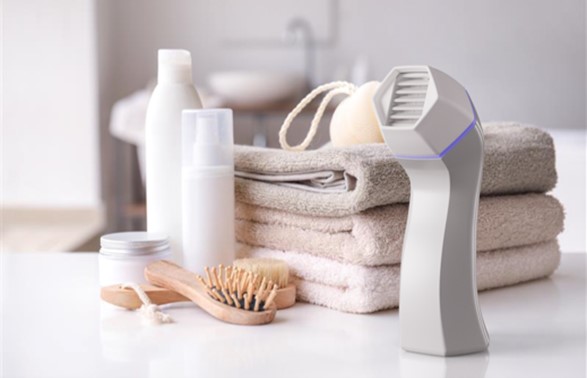Cold plasma research from the International Space Station has found a new terrestrial application through the Spark Funding support offered by European Space Agency and the ESA Technology Broker Germany.
Innovations from space travel have often found their way into our everyday lives. An example of a successful technology transfer is the new product Phlas from terraplasma GmbH, which will be distributed by the newly founded subsidiary Hyped About Science GmbH from spring 2025. This compact skin care device for end users uses innovative cold plasma technology from the aerospace industry to help skin fight pimples, acne and inflammation.
From space travel to your skin
The technology behind Phlas is based on plasma research, which comes from space travel. A plasma physics experiment was developed for basic research that is only possible in zero gravity on the International Space Station (ISS). In the plasma crystal experiment, particles are added to cold plasmas and examined. This experiment makes processes that take place at the atomic level visible to the human eye. This provides researchers with a tool to clarify yet unknown physical processes at the level of the smallest particles, thus enabling new technological developments.
The scientists, led by Professor Dr. Gregor Morfill of the Max Planck Institute for Extraterrestrial Physics, were responsible for the first experiments on the station. Thanks to ESA technology transfer, a programme with the goal of making space technologies available for terrestrial applications, this knowledge base from space could be used for practical applications on Earth.
In 2011, Prof. Dr. Morfill and his daughter, PD Dr. Julia Zimmermann, founded the company terraplasma with the aim of transferring the extensive knowledge gained from cold plasma research into applications on Earth and bringing them to market. This has already been successfully implemented in the fields of medical technology (with the ESA Spark Funding project and the resulting plasma care wound healing device) and hygiene/disinfection (with the PlasmaEgg device for disinfecting objects, which also emerged from an ESA Spark Funding project), as well as in pilot projects in water treatment. Now, the Phlas device for the skincare sector is making another cold plasma innovation accessible to a wide range of users.
Cold plasma technology for healthy skin
Cold plasma is already successfully used in many areas, such as water treatment and the disinfection of objects, as well as in medicine for mobile wound healing, for example with the plasma care device from terraplasma medical GmbH.
With Phlas, space technology is now conquering another area: the regeneration of damaged skin. Through the targeted application of cold plasma, Phlas supports the skin in the care of pimple marks and promotes its resistance to environmental influences. Without creams, without irritating ingredients, just by pressing a button, Phlas releases cold plasma energy that targets problem areas, thus soothing the skin.

From science to market maturity
The path from basic research in space to practical application has been challenging, but successful. The company terraplasma, a spin-off of the Max Planck Institute for Extraterrestrial Physics, has further developed the cold plasma technology and optimised it for use in a variety of applications. In close collaboration with experts and researchers, Phlas has finally been launched as a safe, effective and easy-to-use product for consumers.
Innovation in the care of irritated skin
Phlas is an example of how high-tech from the aerospace industry can improve our daily lives. The innovative plasma technology enables a gentle and effective treatment of skin blemishes – without any side effects or chemical additives. Phlas represents a new generation of skin care products that combines research and practice in a unique way. This is yet another example of how space research not only conquers the cosmos but also benefits people on Earth.
Cold plasma pioneer terraplasma continues its success story with Phlas. Through the targeted application of cold plasma, the consumer device Phlas supports the skin in the care of pimple marks and promotes its resistance to environmental influences. In cooperation with KIMETEC GmbH, the PlasmaEgg was developed, a mobile disinfection device that uses cold plasma technology to disinfect the surfaces of a wide variety of objects effectively and in an environmentally friendly manner. As a next step, terraplasma will increasingly focus on the field of water treatment, as cold plasma has been successfully tested as a sustainable disinfection solution in several pilot projects.
About terraplasma
terraplasma GmbH, founded in 2011 as a spin-off of the renowned Max Planck Society, has set itself the goal of developing innovative solutions with cold plasma. The company, based in Garching near Munich, Germany, relies on in-depth expertise in the fields of science and technology. A dedicated team of scientists, engineers and specialists is working to make cold plasma available as a useful technology in science, business and for private and industrial use.
In addition, terraplasma holds an exclusive worldwide license to commercialise all cold plasma patents of the Max Planck Society. Furthermore, the company owns patents in the field of cold plasma technology, which form the basis for innovative applications in various areas.
ESA Spark Funding
ESA Spark Funding is a tool provided by ESA Technology Broker Germany to support and accelerate technology transfers related to space travel. Both transfers of space technologies to terrestrial applications (spin-off) and transfers of non-space technologies to space travel are possible. The aim is to provide start-up financing for the adaptation or prototype phase, including a marketing strategy for other industries. As technology recipients, funding is primarily provided to SMEs that already have existing product lines. As technology providers, companies of any size as well as research institutions and universities can act as subcontractors. The funding rate is 75% for a project volume of up to €80,000 and a duration of 12 months.
The ESA Technology Broker Germany is managed by EurA AG and cesah GmbH.